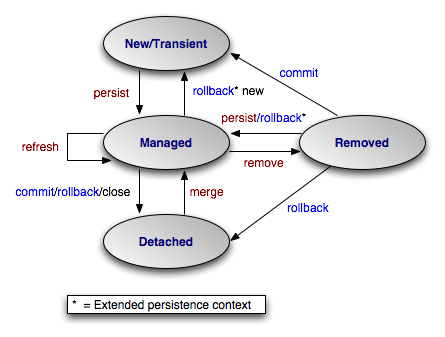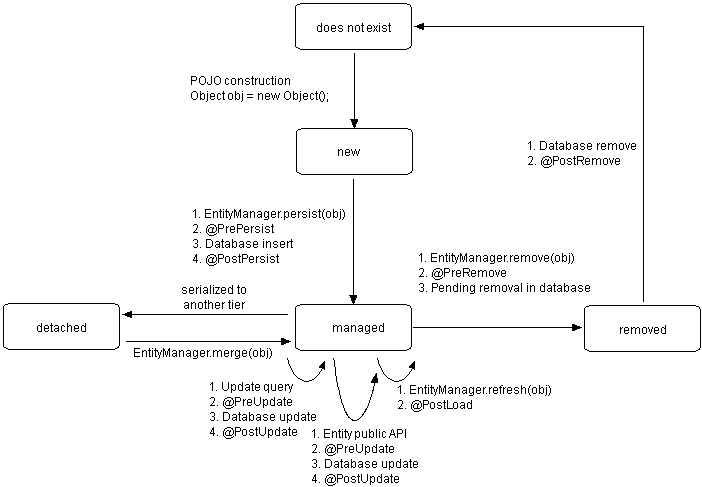JPA basics
Runtime
Core concepts
- A Cache is a copy of data, copy meaning pulled from but living outside the database.
- Flushing a Cache is the act of putting modified data back into the database.
- A PersistenceContext is essentially a Cache. It also tends to have it’s own non-shared database connection.
- An EntityManager represents a PersistenceContext (and therefore a Cache)
- An EntityManagerFactory creates an EntityManager (and therefore a PersistenceContext/Cache)
Cache == PersistenceContext
Entity Manager
A persistence unit is a named configuration of entity classes.
A persistence context is a managed set of entity instances.
An EntityManager instance is associated with a persistence context.
Saying that an entity is managed meas that it’s contained within a persistence context and it can be acted upon by an entity manager.
- An
EntityManagerFactoryis an expensive-to-create, threadsafe object intended to be shared by all application threads. - An
EntityManageris an inexpensive, non-threadsafe object that should be used once, for a single business process, a single unit of work, and then discarded
Container-managed entity manager
@PersistenceContext(unitName="EmployeeService")
private EntityManager em;
It can be injected by using the @PersistenceContext, and you don’t create or manage the lifecycle of the entity manager. This type of entity manager is typically used in Java EE environment.
NOTICE: if you use Spring-orm for JPA integration, this @PersistenceContext is also supported by Spring bean context. A container-managed entity manger requires the use of a JTA transaction.
a. Transaction-scoped It depends on JTA transaction, it use the transaction to trace persistence context. Every time when an operation is invoked on entity manager, the proxy of the persitence manager checks to see whether a persistence is associated with the container JTA transaction. If yes, just use it. If not, it creates a new persistence context and associates it with the transaction. When the transaction ends, the persistence context goes away.
b. Extended Specially designed for stateful bean, the persistence context of extended persistence manager lasts until the end of conversation instead of transaction.
Application-managed entity manager
EntityManagerFactory emf = Persistence.createEntityManagerFactory("EmployeeService");
EntityManager em = emf.createEntityManager();
You can control the entity manager in your application, including its creating, closing, transaction etc. This type of entity manager is typically used in J2SE or some non-EJB Java EE environment.
The best way to create an entity manager is to use the @PersistenceUnit
@PersistenceUnit(unitName="EmpoyeeService")
private EntityManagerFactory emf;
When the application-managed entity manager is created, it creates its own private persistence context that lasts until the entity manager is closed.
An application managed entity manager can be either involved in the current JTA transaction (a JTA entity manager), or the transaction may be controlled through the EntityTransaction API (a resource-local entity manager).
Entity states and operations

Transaction management
two transaction management types:
-
resource-local: using the native transaction of the JDBC driver
-
JTA: Jave EE server, supporting multiple participating resources, transaction lifecycle management, and distributed XA transactions. Also know as global transaction.
Mapping
Table mapping
@Entity
@Table(name="EMP", schema="scott")
Basic mapping
customize the default mapping
lazy fetching
@Basic can specify the lazy fetching mode.
@Basic(fetch=FetchType.LAZY)
specify the column name - @Column
@Column(name="ADDR")
large object - @Lob
@Lob
temporal types for java.util.Date and java.util.Calendar - @Temporal
If you just want to map DATE, TIME, TIMESTAMP to java.sql.Date, java.sql.Time, java.sql.Timestamp, the basic mapping is just OK.
@Temporal(TemporalType.DATE)
private Calendar dob;
transient state - @Transient
transit private String s;
@Transient private String s;
enums - @Enumerated
@Basic
@Enumerated(EnumType.STRING)
private Gender gender;
primary Key
- primitive type: byte, int, short, long, char, (float, double)
- wrapper classes of primitives: Byte, Integer, Short, Long, Character, (Float, Double)
- string: String
- large numeric type: java.math.BigInteger, (java.math.BigDecimal)
- temporal type: java.sql.Date, java.util.Date WARNING: using floating types for primary keys is risky endevour and is not recommended.
there are 4 types of identity generation.
Automatic
@Id @GeneratedValue(strategy=GenerationType.AUTO)
private long id;
The provider can choose table-based strategy or sequence-based strategy. This strategy may need schema generation and is a choice for development or prototyping. It’s not recommended for other cases. You should always specify the other three strategies.
Table
@Id @GeneratedValue(stategy=GenerationType.TABLE)
private long id;
This will use the default table assumed by the provider. So it’s better to declare more detailed generator by giving the specified table.
@TableGenerator(name="Emp_Gen", table="ID_GEN", pkColumnName="GEN_NAME", valueColumnName="GEN_VAL", pkColumnValue="Emp_Gen", initialValue=1000, allocationSize=100000)
@Id @GeneratedValue(generator="Emp_Gen")
private long id;
Sequence
@Id @GeneratedValue(strategy=GenerationType.SEQUENCE)
private long id;
This will also use the default sequence assumed by the provider. But a problem is that this default sequence will be shared by different entity.
@SequenceGenerator(name="Emp_Gen", sequenceName="Emp_Seq", initialValue=1, allocationSize=10000)
@Id @GeneratedValue(generator="Emp_Gen")
private long id;
It depends on whether you enable the schema generation. If no, the sequence must already exist; If yes, the SQL to create the sequence is run by the provider.
Identity
@Id @GeneratedValue(strategy=GenerationType.IDENTITY)
private long id;
Identity column is supported by some databases. Using this mode means the identifier is not available until after commit time.
Relationship
@ManyToMany
@JoinTable(name = "BOOK_AUTHOR",
joinColumns = { @JoinColumn(name = "BOOK_ID", referencedColumnName = "id") },
inverseJoinColumns = { @JoinColumn(name = "AUTHORID", referencedColumnName = "id") })
The three relationships can use _fetch=FetchType.LAZY_.
Inheritance
JPA通过在父类增加@Inheritance(strategy=InheritanceType.xxx)来声明继承关系。A支持3种继承策略:
- 单表继承(InheritanceType.SINGLETABLE),所有继承树上的类共用一张表,在父类指定(@DiscriminatorColumn)声明并在每个类指定@DiscriminatorValue来区分类型。
- 类表继承(InheritanceType.JOINED),父子类共同的部分公用一张表,其余部分保存到各自的表,通过join进行关联。
- 具体表继承(InheritanceType.TABLEPERCLASS),每个具体类映射到自己的表。 其中1和2能够支持多态,但是1需要允许字段为NULL,2需要多个JOIN关系;3最适合关系数据库,对多态支持不好。具体应用时根据需要取舍。
Embeddables
Advanced mapping
element collection
Futhure knowledge
locking
cache
lifecycle callbacks
Event & Listener
